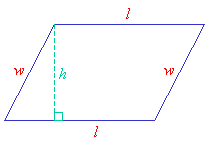Find the area of a parallelogram given these vertices: P1(1,2) P2(4,4) P3(7,5) P4(4,3)?
2 Answers
Area of parallelogram is 3
Explanation:
Given A (1,2), B (4,4), C(3) 7,5), D (4,3)

Slope of
Eqn of AB
Slope of
Eqn of DE is
Solving equations (1) & (2) we get coordinates of point E.
Coordinates of
Length of
Area of parallelogram ABCD =
Contd.....
Explanation:
Prerequisites :
